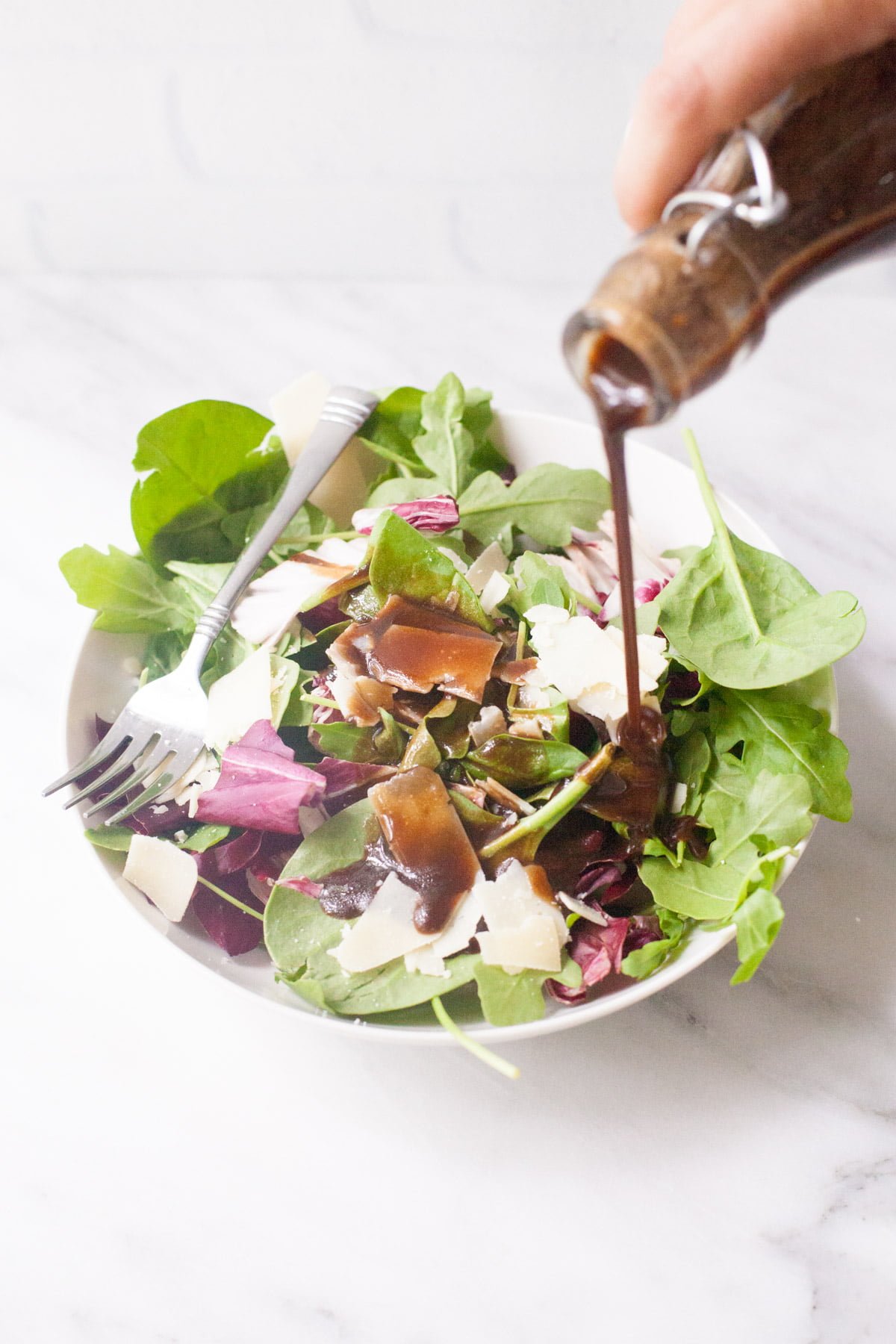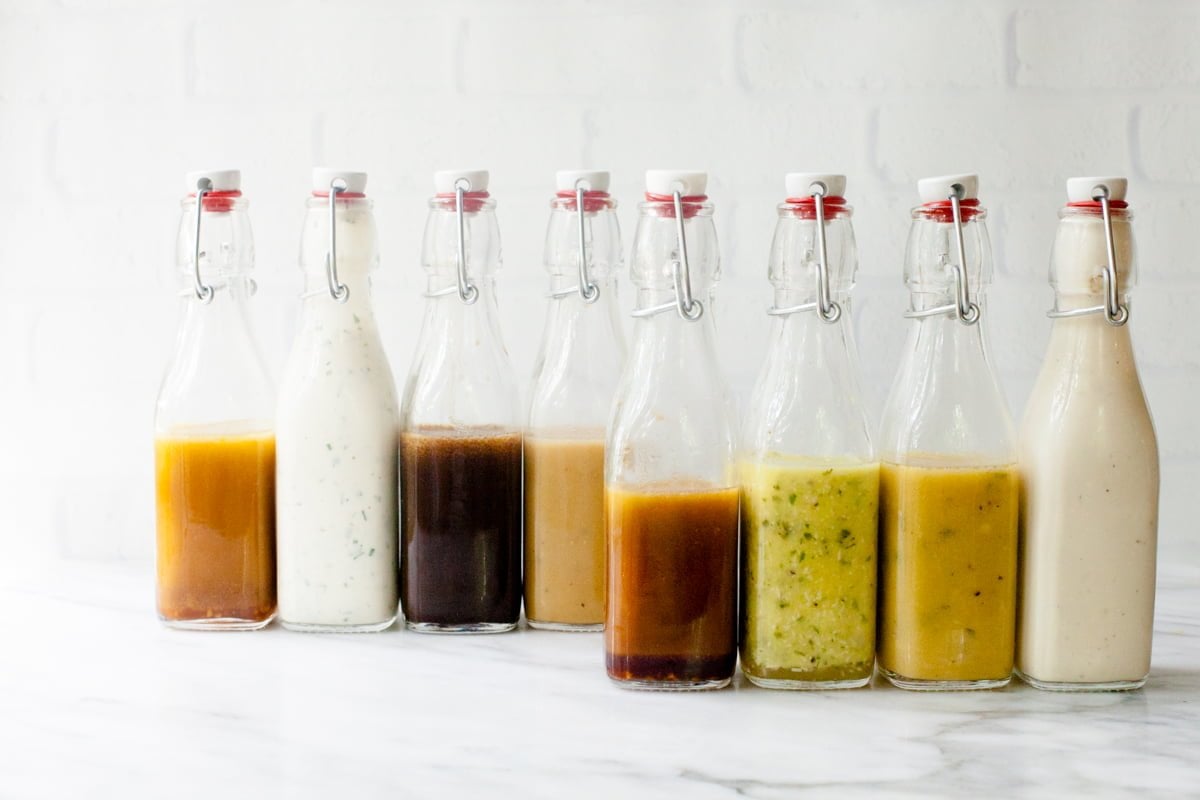
Whenever I tell someone I love healthy food, the first thing they inevitably ask me is if I eat salad all day. Here’s the truth for you: I actually don’t really like salad that much. I am definitely not one of those people who grab a mixing bowl from the cabinet, dump in a bunch of greens, and happily go to town. I am not a rabbit, and I don’t enjoy eating like one.
For me, for a salad to be good, it has to be something substantial. It has to have a great mix of flavors, textures, and really good dressing. I love veggies, but let’s call a spade a spade—veggies can be boring-tastic if you don’t do something to spice them up a little bit. And a good salad dressing goes a looooooong way to making veggies exciting (even for those folks who aren’t big veggie fans—like my two year old, who happily chows down on raw cucumbers and tomatoes when they are dipped in the Greek Yogurt Ranch Dressing you’ll see below).

Why should I make homemade salad dressings?
Salad dressings are super easy to make at home, and I think learning how to make your favorite salad dressings in your own kitchen is a super useful skill to have. It’ll save you tons of cash. The markup on bottled salad dressings is OUTRAGEOUS—most of them you can make for pennies on the dollar.
You can also completely control the ingredients. Have you ever cruised the salad dressing aisle and checked ingredient lists? Many of them are packed with artificial colors and flavors, which just aren’t necessary
And my favorite part is that you can completely customize the taste to your liking. Once you land on your “house dressing” that is perfect for your family’s tastebuds, you always will have that recipe in your pocket.

What ingredients do I need for these dressings?
Below, I’m sharing fifteen of my favorite simple, easy, and healthy salad dressing recipes that you can make at home. Honestly, you probably have most of the ingredients to make most of the dressings already in your pantry and fridge—there are no fancy pants ingredients that you’ll have to track down at a specialty store.
For most salad dressings, you’ll need:
- Something acidic. Lemon juice, lime juice, balsamic vinegar, red wine vinegar, apple cider vinegar, or white wine vinegar are all good choices.
- Some fat. Oil is a standard ingredient in most vinaigrette-style dressings. With a few exceptions (looking at you, sesame oil in the ginger-sesame dressing), you want a mildly-flavored oil that won’t stand out in the dressing. Extra virgin olive oil or avocado oil are my favorites.
- Something sweet. A little sweetness can bring all the flavors together and round out the dressing. Honey is my go-to, but maple syrup, agave, or even a bit of granulated sugar will work as well.
- Salt, pepper, garlic, and other herbs and spices. Salt and pepper will enhance the flavor of the other ingredients—don’t skip them where they are called for!
All of these recipes can be made using the jar-and-shake method. Just grab a jar with a tight-fitting lid (I use a wide-mouth pint mason jar and a plastic cap), toss in all the ingredients, and shake the dickens out of it until it’s well-blended. There are a couple of recipes below that could be made smoother if you use a food processor or a blender—but you don’t have to if you’re fine with a chunkier dressing.

How long do homemade salad dressings last?
All the recipes below make about one cup of dressing—enough to last for a few days of salads, but not so much that it goes bad before you get a chance to use it up. Use up the dressings with dairy in them within a week. The vinaigrettes can last two or more weeks in the fridge in an airtight container.
Do I need fresh herbs or dried herbs?
Each recipe below has amounts for using fresh OR dried herbs—you can use all fresh, all dried, or any combination of the two. Just keep in mind that the dried herbs will take a while longer to impart their flavor on the dressing. A good rule of thumb is that if you’re using mostly fresh ingredients, you can get by with using your dressings within 15-30 minutes. If you’re using mostly dried ingredients, you’d be better off waiting 2+ hours so the flavors can really develop. Let’s get started.
If you master a handful of these easy salad dressing recipes, you’ll be in good shape to never buy the bottle stuff again if you don’t want to.

















